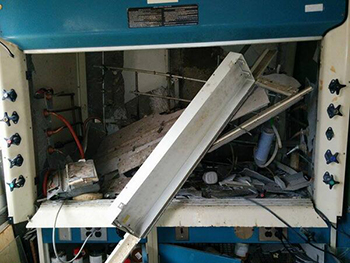|
When Trimethylsilyl Azide Preparation Goes Wrong

The photo above was taken by the University of Minnesota and reveals the aftermath of a laboratory explosion that occurred when synthesizing trimethylsilyl azide.
The reaction detonated with a force so great that it broke all sides of the fume hood, damaged the neighboring hood and broke an exterior window. The student was fortunate to receive minor burns and wounds from the flying glass and was released from the hospital.
Please click here to read about the precautions that must be taken when working with azido compounds.

Thermo Savant Refrigerated Vapor Trap Electrical Fire
We had a near miss in a laboratory that highlights the importance of reporting near misses. A Thermo Savant refrigerated vapor trap evaporator model RVT 4104-115 developed an internal short or electrical malfunction over a June weekend that caused the power cord to overheat and catch fire. The unit was in a chemical fume hood and we were fortunate that there was no other damage to the lab or surrounding equipment.
If you have a similar refrigerated vapor trap please ensure it is serviced properly and please report any near misses such as this so we can inform other laboratory personnel and potentially prevent an accident, fire or injury. Click here for more pictures .


Shorts and Sandals are Appropriate for the Beach, but not the Lab

It is summer and this is the time of the year where laboratory personnel want to begin wearing shorts and sandals in the laboratories. Adequate protective clothing must be worn whenever working in the laboratory. “Adequate” means, at a minimum, clothing that falls below the knees and shoes that fully cover the feet. These, of course, are in addition to other personal protective equipment such as a lab coat, gloves and eye wear.
Please click here to read about the importance of ensuring you are properly clothed when working in a laboratory.

Radiation Safety Newsletter
If you are a Permit Holder do you know what the liquid scintillation counter (LSC) service & “retirement” requirements are? Do you know how to remove radionuclide users from permits? Find the answers to these questions and more in the recent Radiation Safety Newsletter found here

|